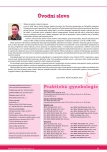Pharmacotherapy of endometriosis in reproductive gynaecology
Authors:
R. Hudeček; G. Jelenek; Michal Felsinger
Authors‘ workplace:
Gynekologicko-porodnická klinika, LF MU a FN Brno
Published in:
Prakt Gyn 2011; 15(2): 70-77
Category:
Review Article
Overview
Endometriosis is defined as an ectopic presence of endometrial tissue outside the uterine cavity causing a chronic inflammatory reaction. Aetiology of endometriosis is most likely multifactorial; retrograde menstruation is a very popular theory, though immune system appears to play an important role. The signs and symptoms of endometriosis include chronic pelvic pain, irregular and strong menstrual bleeding, bleeding between periods, dyspareunia and fertility disorders. The paper provides an overview of the current options available for classification of endometriosis of the lesser pelvis, summarizes epidemiological factors and pathogenetic mechanisms pertaining to the localization of ectopic foci. The paper defines possible clinical signs of the various forms of endometriosis and provides an overview of current options for pharmacological treatment. Hormonal treatment options include administration of oral contraception, progestin-only pills (POP), depot progestins – implants, intrauterine system (IUS) with levonorgestrel, progestins with respect to the results of recent clinical trials with dienogest. Furthermore, therapeutic effects of selective progesterone receptor modulators (SPRM), GnRH analogues and antagonists and Add-back therapy are presented. The overview is completed with a discussion on therapeutic options provided by selective estrogen receptor modulators (SERM), selective aromatase inhibitors (AI) and anti-inflammatory and immunomodulatory therapy. The decision to use pharmacological or surgical treatment of genital forms of endometriosis, or their combination, should be based on the type of endometriosis being treated, i.e. whether this is peritoneal, ovarian, rectovaginal or extragenital form or adenomyosis. The character of pelvic pain and the presence of infertility also influence the choice of suitable therapeutic approach. Microscopic description of ectopic endometrial foci also affects the final outcome of hormonal therapy.
Key words:
endometriosis – pharmacotherapy of endometriosis – infertility – dysmenorrhoea - dyspareunia
Sources
1. Koninncky PR, Martin DC. Deep endometriosis: a consequence of infiltration or retraction or possibly adenomyosis externa? Fertil Steril 1992; 58(5): 924–928.
2. Paul Dmowski W, Braun DP. Immunology of endometriosis. Best Pract Res Clin Obstet Gynaecol 2004; 18(2): 245–263.
3. Lebovic DI, Mueller MD, Taylor RN. Immunobiology of endometriosis. Fertil Steril 2001; 75(1): 1–10.
4. Kučera E. Endometrióza. In: Kučera E (ed). Farmakoterapie pro praxi, sv. 26. Praha: Maxdorf 2008.
5. Abrao MS, Neme RM, Carvalho FM et al. Histological classification of endometriosis as a predictor of response to treatment. Int J Gynaecol Obstet 2003; 82(1): 31–40.
6. Nisolle M, Donnez J. Peritoneal endomet-riosis, ovarian endometriosis, and adenomyotic nodules of the rectovaginal septum are free different entities. Fertil Steril 1997; 68(4): 585–596.
7. Al-Fozan H, Tulandi T. Left lateral predisposition of endometriosis and endometrioma. Obstet Gynecol 2003; 101(1): 164–166.
8. Leyendecker G, Kunz G. Endometriosis and adenomyosis. Zentralbl Gynakol 2005; 127(5): 288–294.
9. Sinaii N, Cleary SD, Ballweg ML et al. High rates of autoimmune and endocrine disorders, fibromyalgia, chronic fatigue syndrome and atopic diseases among women with endometriosis: a survey analysis. Hum Reprod 2002; 17(10): 2715–2724.
10. Wu MY, Ho NH. The role of cytokines in endometriosis. Am J Reprod Immunol 2003; 49(5): 285–296.
11. Attar E, Bulun SE. Aromatase and other steroidogenic genes in endometriosis: translational aspects. Hum Reprod Update 2006; 12(1): 49–56.
12. Kitawaki J, Noguchi T, Amatsu T et al. Expression of aromatase cytochrome P450 protein and messenger ribonucleic acid in human endometriotic and adenomyotic tissue but not in normal endometrium. Biol Reprod 1997; 57(3): 514–519.
13. Viganò P, Parazzini F, Somigliana E et al. Endometriosis: epidemiology and aetiological factors. Best Pract Res Clin Obstet Gynaecol 2004; 18(2): 177–200.
14. Manolopoulos K, Tinneberg HR. Endometriosis and infertility. Zentralbl Gynakol 2005; 127(5): 325–328.
15. Feyereisl J, Zavadil M, Krofta L et al. Endometrióza imitující nádor močového měchýře. Čes Gynek 2005; 70(2): 152–155.
16. Kurman RJ. Blaustein’s Pathology of the Female Genital Tract. 5th ed. New York: Springer 2002.
17. Sharpe-Timms KL, Young SL. Understanding endometriosis is the key to successful therapeutic management. Fertil Steril 2004; 81(5): 1201–1203.
18. Mahutte NG, Arici A. Medical management of endometriosis-associated pain. Obstet Gynecol Clin North Am 2003; 30(1): 133–150.
19. Gomes MK, Ferriani RA, Rosa e Silva JC et al. The levonorgestrel-releasing intrauterine system and endometriosis staging. Fertil Steril 2007; 87(5): 1231–1234.
20. Strowitzki T, Faustmann T, Gerlinger C et al. Dienogest in the treatment of endometriosis-associated pelvic pain: a 12-week, randomized, double-blind, placebo-controlled study. Eur J Obstet Gynecol Reprod Biol 2010; 151(2): 193–198.
21. Köhler G, Faustmann TA, Gerlinger C et al. A dose-ranging study to determine the efficacy and safety of 1, 2, and 4 mg of dienogest daily for endometriosis. Int J Gynaecol Obstet 2010; 108(1): 21–25.
22. Chabbert-Buffet N, Meduri G, Bouchard P et al. Selective progesterone receptor modulators and progesterone antagonists: mechanisms of action and clinical applications. Hum Reprod Update 2005; 11(3): 293–307.
23. Schweppe KW. Guidelines for the use of GnRH-analogues in the treatment of endometriosis. Zentralbl Gynakol 2005; 127(5): 308–313.
24. Schindler AE, Christensen B, Henkel A et al. High-dose pilot study with the novel progestogen dienogestin in patients with endometriosis. Gynecol Endocrinol 2006; 22(1): 9–17.
25. Crha I, Ventruba P Anticardiolipin and antihiston levels during the treatment of IVF patients with endometriosis by Goserelin. J Assist Reprod Genet 1996; 13(4): 366–368.
26. Zupi E, Marconi D, Sbracia M et al. Add-back therapy in the treatment of endometriosis-associated pain. Fertil Steril 2004; 82(5): 1303–1308.
Labels
Paediatric gynaecology Gynaecology and obstetrics Reproduction medicineArticle was published in
Practical Gynecology

2011 Issue 2
Most read in this issue
- GyneFix – a frameless intrauterine device
- Pharmacotherapy of endometriosis in reproductive gynaecology
- The prognostic value of the SCCA tumour marker in patients surgically treated for squamous cell cervical cancer
- Probiotics in gynaecology
